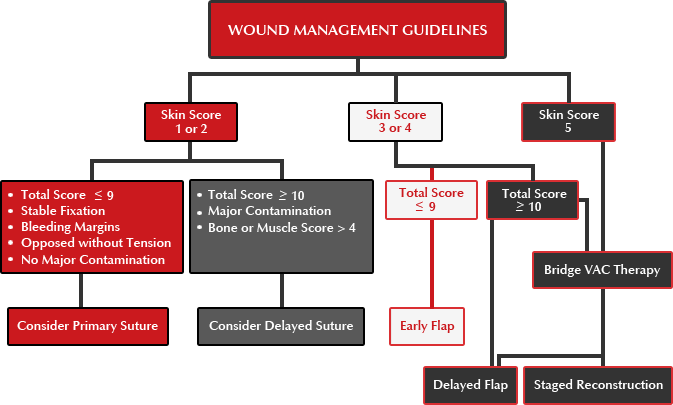Overview
The Ganga Hospital Open Injury Score (GHOISS) is a simple scoring system that has been developed for doctors to grade the severity of injury in an open tibia fracture. The final calculated score can be subsequently be used to:
- Guide the difficult decision of limb salvage or amputation
- Advise wound management
- Predict key patient outcomes and treatment
What is the GHOISS
The Ganga Hospital Open Injury Score (GHOISS) is a score developed to prognosticate limb salvage and outcome measures in open tibia fractures. The score was developed after systematic review of 88 Open Injury cases of the lower limb and their 5 year follow up at Ganga Hospital, Coimbatore. It was subsequently validated in a number of further trials.
Advantages of GHOISS :
- It acts as a predictable single scoring system for limb salvage and gives guidelines for management
- It has a very high inter-observer agreement rate
- It evaluates the severity of injury to individual tissue components
- Co-morbid factors are also included to evaluate the outcome
- Has a high degree of sensitivity and specificity in guiding towards salvaging or amputating the injured limb
Components of GHOISS
Covering tissues (skin and fascia) – S1 to S5 Wounds without skin loss, which have an adequate soft-tissue bed and can be approximated without tension after debridement are given a score of one if they do not overlie the fracture and two if they expose it. Wounds with primary skin loss or which require extensive debridement of the skin due to friction burns or degloving have a score of three if they are not over the fracture site and four if they expose it. Wounds involving skin loss over the entire circumference of the limb have a score of five.
Skeletal structures (bone and joints) – B1 to B5
Transverse or oblique fractures or a butterfly fragment involving less than 50% of the circumference have a score of one. The presence of a large butterfly fragment involving more than 50% of the circumference indicates a score of two and extensive comminution or segmental fractures without loss of bone a score three. Primary or secondary loss of bone of less than 4 cm has a score of four and of more than 4 cm a score of five.
Functional tissues (muscles, tendons and nerve units) – M1 to M5 Exposure of musculotendinous units of any size with only partial direct damage of muscle units has a score of one, a complete but repairable injury with no resultant loss of function a score of two, and irreparable injury resulting in partial loss of a compartment or a complete injury to the posterior tibial nerve has a score of three. Extensive damage of one entire compartment has a score of four and loss of more than one compartment a score of five.
Comorbid factors – Co 0 to 14 Factors which have a negative influence on the management, either by increasing the anaesthetic risk for major surgical procedures or the outcome in open injuries, are each given a score of two. An interval of more than 12 hours before debridement of the injury, farmyard injuries or sewage or organic contamination, age above 65 years, drug-dependent diabetes mellitus, the presence of cardiorespiratory diseases leading to an increased anaesthetic risk, polytrauma involving chest and abdominal injuries with an Injury Severity Score > 25, fat embolism, hypotension with a systolic pressure of less than 90 mmHg at presentation, a compartment syndrome or another major injury to the same limb are each given a score of two.
CALCULATE SCORESalvage vs Amputation
Open injuries are often dramatic and present major challenges in the decision of limb salvage versus amputation. An error in judgement leading to failed salvage after multiple failed reconstructions can cause considerable distress to the patient and family from pain, longer hospital stays, huge social and financial losses and emotional trauma.
The GHOISS score can be used to provide guidance on which limbs are likely to undergo successful salvage and those that would most probably require amputation. The score is unique because it provides a ‘grey zone’ where the decision needs to be on a case-by-case basis. The scale below shows how the total score can be used in the decision making process:

CALCULATE SCORE
Wound Management
The timing and type of wound management can pose challenges in open tibia fractures as there are no clear guidelines. Delays in wound cover or a too early reconstruction can lead to disasters of infection or reconstruction failures. The GHOISS can be useful to guide the timing of closure in wounds meeting specific criteria and has been shown to have good outcomes. It has also been shown to be useful in predicting the requirement for soft tissue reconstruction following satisfactory debridement. The flowchart below shows how the GHOISS can be used to guide wound management:

CALCULATE SCORE
Treatment Outcomes
Following an open tibia fracture, there is frequently anxiety amongst the patient and relatives regarding the likely treatment course and final expected outcomes. The ability of the healthcare professional to provide guidance on these important issues depends on their experience, which is often limited due to the infrequent presentation of these injuries. The GHOISS has been used to create a validated model to predict:
- The total length of treatment
- The number of surgeries that will be required
- The number of hospital admissions
- The number of days spent in hospital
- The final functional outcome
- Bony union time
These factors will be important in patients’ decision making and planning, especially in countries where the family is responsible for the financial costs of healthcare admissions.
CALCULATE SCOREResources
A Score for predicting salvage and outcome in Gustilo type III - A type III - B open tibial fractures & JBJS 2006: Volume B-88, No. 10, October 2006
S. Rajasekaran,
J. Naresh Babu,
J. Dheenadhayalan,
A. P. Shetty,
S. R. Sundararajan,
M. Kumar,
S. Rajasabapathy
Contact Us: rajasekaran.orth@gmail.com